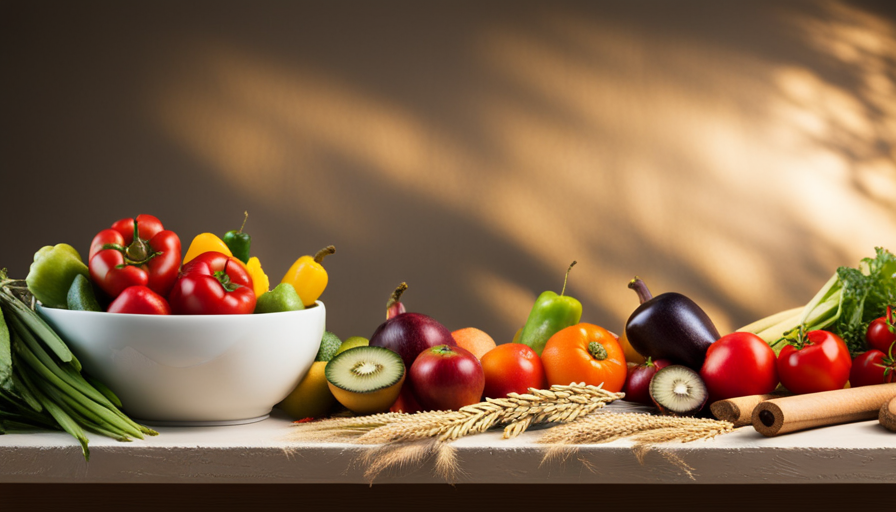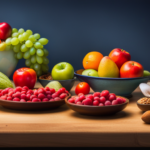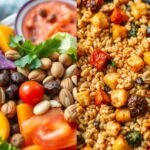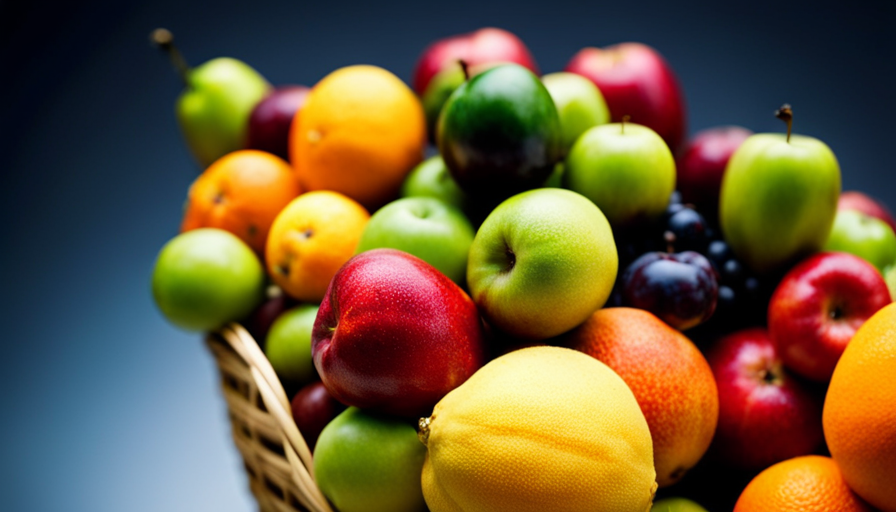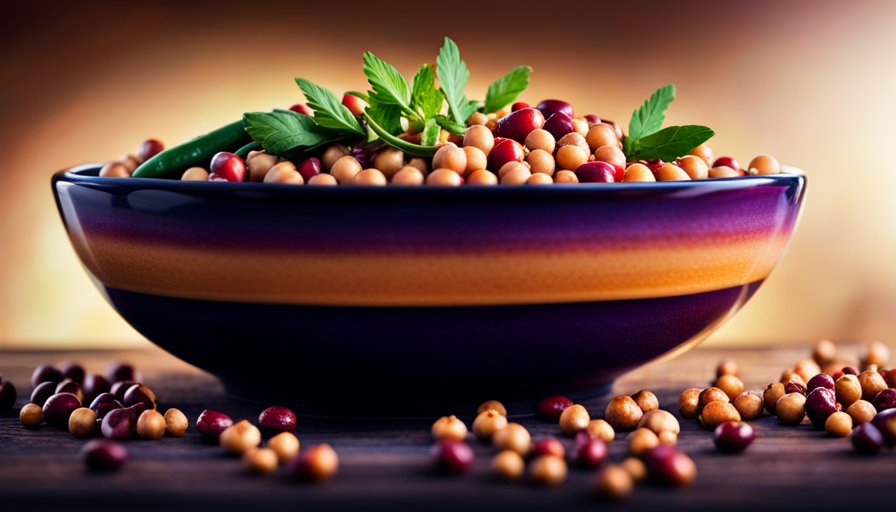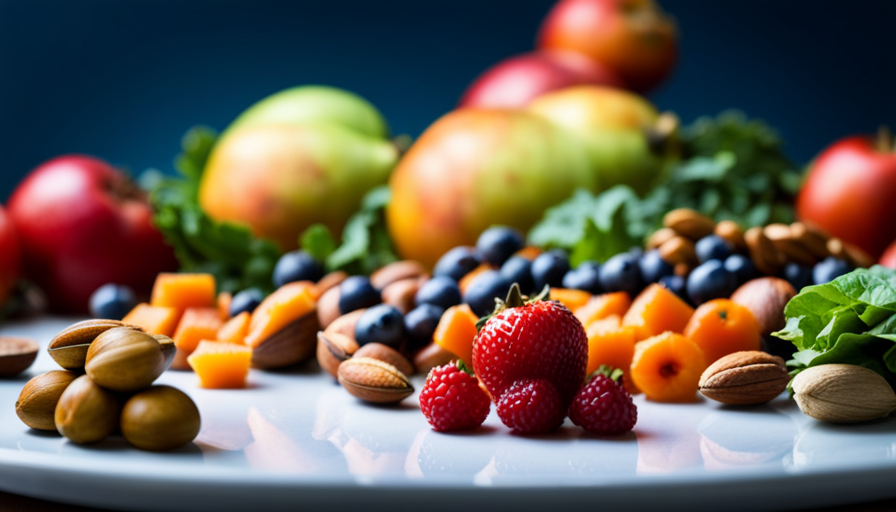Oh, the enchanting realm of food enzymes. These underappreciated heroes in the world of cooking. Let me shed some light on this, my respected readers. Hidden within raw food is a puzzle – a puzzle that holds the key to improving digestion and optimizing nutrient absorption.
We often overlook these magnificent enzymes, focusing instead on the flavors and textures of our meals. But oh, how we underestimate their power.
Food enzymes, my friends, are the catalysts that break down the complex molecules in our food, making them easier for our bodies to digest and absorb. Found abundantly in fruits, vegetables, dairy products, and even meat, these little wonders work tirelessly behind the scenes, ensuring that our bodies receive maximum nourishment.
In this article, we shall delve into the different types of food enzymes found in raw foods, exploring their benefits and unraveling the mysteries of their role in digestion. We shall also examine how cooking affects enzyme activity and provide tips on how to preserve and maximize the enzyme content in raw foods.
So join me, as we embark on a journey into the fascinating world of food enzymes, where science meets taste, and where the true power of raw foods is revealed.
Key Takeaways
- Raw foods, particularly fruits and vegetables, are abundant sources of food enzymes.
- Enzymes such as amylase, protease, and lipase found in raw foods aid in the breakdown and digestion of complex molecules like carbohydrates, proteins, and fats.
- Enzyme supplements can enhance digestion and nutrient absorption, particularly for meat proteins.
- Maximizing enzyme content in raw foods by choosing organic produce, consuming shortly after harvesting, and proper storage can help reap the nutritional benefits and support overall health.
Introduction to Food Enzymes
Get ready to discover the wonders of food enzymes found in raw foods – they’re about to blow your taste buds away! Food enzymes are essential proteins that play a crucial role in the digestion and absorption of nutrients in our bodies. They act as catalysts, speeding up chemical reactions and breaking down complex molecules into simpler forms that our bodies can easily utilize. Enzyme functions include aiding in the digestion of carbohydrates, proteins, and fats, as well as facilitating the absorption of vitamins and minerals.
Raw foods are a great source of enzyme-rich foods. When food is cooked or processed, the high temperatures and mechanical actions destroy these delicate enzymes, rendering them inactive. However, when we consume raw foods, we benefit from the intact and active enzymes present in them.
Fruits and vegetables, in particular, are abundant in food enzymes. These natural enzymes help break down the complex carbohydrates, proteins, and fats present in these foods, making them easier for our bodies to digest and absorb.
Now that we understand the importance of food enzymes and their presence in raw foods, let’s explore the different types of food enzymes found in fruits and vegetables.
Types of Food Enzymes Found in Fruits and Vegetables
You’ll be amazed by the incredible variety of enzyme-rich goodness lurking within the vibrant world of fruits and vegetables. These natural wonders contain a wide range of food enzymes that play vital roles in our digestion and overall health.
Here are three types of food enzymes commonly found in fruits and vegetables:
-
Amylase: This enzyme breaks down complex carbohydrates into simpler sugars, aiding in their digestion. Fruits like bananas and apples, as well as vegetables like sweet potatoes and carrots, are rich sources of amylase.
-
Protease: Found abundantly in fruits like pineapple and papaya, as well as vegetables like broccoli and spinach, protease helps in breaking down proteins into amino acids, facilitating their absorption by the body.
-
Lipase: Lipase is responsible for breaking down fats into fatty acids and glycerol. Avocados, olives, and tomatoes are some fruits that contain lipase, while vegetables like peas and lentils also provide this enzyme.
Enzymes in grains and legumes are also important. Whole grains like wheat and oats contain enzymes that aid in the breakdown of complex carbohydrates, making them easier to digest. Legumes, such as chickpeas and lentils, contain enzymes that help break down proteins, enhancing their nutritional value.
With a better understanding of the types of food enzymes present in fruits, vegetables, grains, and legumes, we can appreciate the significant role they play in our digestive processes. Moving forward, let’s explore the benefits of enzymes in raw dairy products.
Benefits of Enzymes in Raw Dairy Products
Indulging in creamy, unprocessed dairy products is like savoring a delectable, enzyme-packed symphony for your taste buds. Raw dairy products, such as milk, cheese, and yogurt, are not only rich in essential nutrients but also contain a variety of enzymes that offer numerous benefits to our health.
One of the key benefits of enzymes in raw dairy products is their role in improving digestion. Enzymes like lactase help break down lactose, the sugar found in milk, making it easier for lactose intolerant individuals to enjoy dairy without discomfort. Additionally, enzymes in raw dairy products can enhance nutrient absorption by assisting in the breakdown of proteins and fats, allowing our bodies to better absorb and utilize these vital nutrients.
Incorporating more raw dairy into your diet can provide these enzyme benefits, supporting optimal digestion and nutrient absorption.
In the subsequent section about the role of enzymes in meat digestion, we will explore how these powerful catalysts aid in breaking down proteins found in meat, ensuring efficient digestion and nutrient extraction.
The Role of Enzymes in Meat Digestion
Sink your teeth into a carnivorous feast, and let the powerful enzymes in your stomach work their magic on breaking down the proteins in meat for efficient digestion and nutrient extraction. The role of enzymes in meat digestion is crucial, as they play a key role in breaking down complex proteins into smaller peptides and amino acids, which can then be absorbed by the body. This process begins in the stomach, where the enzyme pepsinogen is released and activated by the acidic environment. Pepsinogen then converts into pepsin, which specifically targets and breaks down proteins.
To further enhance meat digestion, enzyme supplements can be used. These supplements contain protease enzymes, which assist in the breakdown of proteins and improve nutrient absorption. By taking enzyme supplements, individuals with digestive issues or those who consume large amounts of meat can experience improved digestion and reduced discomfort.
To visualize the role of enzymes in meat digestion, refer to the table below:
| Enzyme | Substrate | Product |
|---|---|---|
| Pepsin | Proteins | Peptides |
| Protease | Proteins | Amino Acids |
The role of enzymes in meat processing is vital for efficient digestion and nutrient extraction. Enzyme supplements can be used to enhance meat digestion, especially for individuals with digestive issues. Now, let’s delve into the enzymatic breakdown of carbohydrates in raw foods.
Enzymatic Breakdown of Carbohydrates in Raw Foods
Get ready to experience the mouthwatering transformation as your body’s natural powerhouses work their magic, breaking down the complex carbohydrates in your favorite dishes into simple sugars for maximum flavor and energy extraction.
Carbohydrate breakdown is a crucial process that occurs in our bodies, enabling us to extract the necessary energy from the food we consume. Raw food enzymes play a vital role in this process, as they’re responsible for catalyzing the breakdown of complex carbohydrates, such as starches and fibers, into simple sugars like glucose and fructose.
Raw food enzymes, including amylase, cellulase, and invertase, are naturally present in raw fruits, vegetables, and grains. These enzymes initiate the breakdown of carbohydrates by breaking the chemical bonds that hold them together. Amylase specifically targets starches, breaking them down into maltose, a disaccharide. Cellulase, on the other hand, breaks down cellulose, a type of fiber, into glucose molecules. Invertase acts upon sucrose, breaking it down into its components, glucose, and fructose.
The enzymatic breakdown of carbohydrates in raw foods not only enhances the flavor but also improves the nutritional value of these foods. By converting complex carbohydrates into simple sugars, our bodies can easily absorb and utilize the energy stored in them. This process is essential for maintaining energy levels and supporting various bodily functions.
As we delve deeper into the world of raw food enzymes, it’s crucial to explore their role in protein digestion and the breakdown of proteins into amino acids for optimal nutrition.
Protein Digestion and Enzymes in Raw Foods
Protein digestion in raw foods is facilitated by the action of specific enzymes, breaking down proteins into amino acids for optimal nutrition. These enzymes, known as proteases, work by breaking the peptide bonds that hold amino acids together in proteins.
One of the most commonly known proteases is called pepsin, which is produced in the stomach and is responsible for the initial breakdown of proteins. In addition to pepsin, there are other enzymes present in raw foods that aid in protein digestion, such as bromelain found in pineapples and papain found in papayas. These enzymes can help to further break down proteins into smaller peptides and amino acids, making them more easily absorbed by the body.
Protein absorption is essential for various bodily functions, including the growth and repair of tissues, the production of enzymes and hormones, and the maintenance of a healthy immune system. However, some individuals may have difficulty digesting proteins properly, leading to digestive discomfort or nutrient deficiencies. In such cases, enzyme supplements may be beneficial. These supplements contain specific enzymes that can help break down proteins more effectively, improving protein absorption and reducing digestive symptoms.
Enzyme supplements are available in various forms, including capsules, tablets, and powders, and can be taken with meals to enhance protein digestion.
In the subsequent section about enzymes and nutrient absorption in the body, we will explore the role of enzymes in breaking down other macronutrients, such as carbohydrates and fats, and discuss how they contribute to overall nutrient absorption.
Enzymes and Nutrient Absorption in the Body
The remarkable thing about our bodies is how enzymes play a crucial role in breaking down different macronutrients like carbohydrates and fats, allowing us to absorb all the necessary nutrients for our overall health and well-being.
Enzymes are vital for gut health as they help in the digestion and absorption of nutrients. They break down complex molecules into smaller, more manageable ones that can be easily absorbed by the body. Without enzymes, our bodies would struggle to extract the essential vitamins, minerals, and other nutrients from the food we consume.
Enzymes also have a significant impact on weight loss. Certain enzymes, like lipase, break down fats into fatty acids, which can then be utilized as a source of energy. By enhancing the activity of these enzymes, it may be possible to increase fat breakdown and promote weight loss.
Additionally, enzymes can improve digestion, reducing bloating and discomfort, which can indirectly contribute to weight loss by promoting a healthier gut environment.
Transitioning to the subsequent section about the impact of cooking on enzyme activity, it is important to note that cooking can affect the activity of enzymes in raw foods.
The Impact of Cooking on Enzyme Activity
When you cook your meals, the heat applied alters the structure of the enzymes, reducing their activity and potentially affecting the overall nutrient absorption in your body. Enzymes are highly sensitive to temperature, and when heated above a certain point, their shape and structure undergo a process called denaturation.
This impact of heat on enzymes can vary depending on the type of enzyme and the specific cooking method used. Denaturation occurs when the heat disrupts the bonds that hold the enzyme’s three-dimensional structure together. As a result, the enzyme loses its shape and becomes less effective in catalyzing chemical reactions in the body. This can potentially lead to a decrease in nutrient absorption, as enzymes play a crucial role in breaking down food particles into smaller, absorbable molecules.
Different cooking methods have varying degrees of impact on enzyme activity. For example, high-temperature cooking methods such as boiling, frying, or baking can cause significant denaturation, while gentler cooking methods like steaming or sautéing at lower temperatures may have a lesser impact on enzyme activity.
In the subsequent section about maximizing enzyme content in raw foods, I’ll provide tips on how to preserve these valuable enzymes and ensure their availability in your diet without compromising their activity through cooking.
Tips for Maximizing Enzyme Content in Raw Foods
To truly unlock the vibrant potential of nature’s culinary masterpieces, embrace the raw and unadulterated essence of fruits and vegetables, preserving their enzymatic magic and allowing it to dance upon your taste buds. Maximizing enzyme content in raw foods is key to reaping the full nutritional benefits they offer.
Here are some tips to help you do just that:
-
Opt for organic produce: Choosing organic fruits and vegetables ensures that they’re free from pesticides and other chemicals that can interfere with enzyme activity.
-
Eat them fresh: Enzymes are delicate and can be easily destroyed by heat, light, and air. Consuming raw foods shortly after they’re harvested preserves their enzyme content.
-
Store them properly: Proper storage is crucial to maintaining enzyme activity. Keep your raw foods in a cool, dark place to slow down the degradation of enzymes.
By incorporating more raw foods into your diet for enzyme benefits, you’ll not only enhance your culinary experience but also nourish your body with vital nutrients.
So, let’s explore the next section and discover the various ways to incorporate these enzyme-rich recipes into your daily meals.
Incorporating More Raw Foods into Your Diet for Enzyme Benefits
Embrace the vibrant potential of nature’s culinary masterpieces by incorporating more of their enzymatic magic into your daily meals. Raw foods are packed with enzymes that can support digestion and overall health. By including more raw foods in your diet, you can maximize the enzyme content and reap the benefits they offer.
One way to incorporate more raw foods into your diet is by trying out raw food recipes for enzyme-rich meals. These recipes often include a variety of fruits, vegetables, nuts, and seeds, which are all excellent sources of enzymes. You can make delicious salads, smoothies, and even desserts using raw ingredients that retain their enzyme activity.
The link between enzyme deficiency and health issues is well-established. When our bodies don’t have enough enzymes, it can lead to poor digestion, nutrient deficiencies, and a weakened immune system. By consuming more raw foods with their natural enzyme content, you can help to prevent these issues and promote better overall health.
To inspire you to incorporate more raw foods into your diet, here is a table showcasing some enzyme-rich fruits and vegetables:
| Fruit | Enzyme Content |
|---|---|
| Pineapple | Bromelain |
| Papaya | Papain |
| Avocado | Lipase |
| Mango | Amylase |
| Kiwi | Actinidin |
By including these enzyme-rich foods in your meals, you can enhance your body’s natural enzyme production and support optimal digestion and health.
Frequently Asked Questions
Can food enzymes from raw foods be harmful to our health?
Food enzymes from raw foods can have potential benefits for our health. They aid in digestion, promote nutrient absorption, and support overall gut health. However, there are also potential risks associated with consuming these enzymes. In some cases, they may cause digestive discomfort or allergic reactions. It’s important to note that cooking can deactivate these enzymes, so individuals should consider their own unique health needs and consult with a healthcare professional before making any dietary changes.
Are there any specific fruits and vegetables that are particularly rich in food enzymes?
Specific fruits and vegetables that are particularly rich in food enzymes include pineapple, papaya, kiwi, mango, and avocado. These fruits contain enzymes such as bromelain, papain, actinidin, and lipase, which aid in the digestion and absorption of nutrients.
The benefits of food enzymes in raw foods are numerous, including improved digestion, increased nutrient availability, and reduced inflammation. Incorporating these enzyme-rich fruits and vegetables into our diet can support overall health and enhance the body’s natural digestive processes.
Can consuming raw dairy products with enzymes help improve digestion for those with lactose intolerance?
Consuming raw dairy products with enzymes can potentially improve digestion for those with lactose intolerance. There’s scientific evidence supporting the use of food enzymes for this condition. Enzymes like lactase can help break down lactose, the sugar found in dairy products, into more easily digestible forms. This can alleviate symptoms such as bloating, gas, and diarrhea.
However, it’s important to note that individual responses may vary, and consulting a healthcare professional is recommended.
How do enzymes in raw meats aid in the digestion process?
Enzymes in raw meats play a crucial role in the digestion process by breaking down proteins for easier absorption. These enzymes, such as proteases, act on protein molecules, breaking them into smaller peptides and amino acids.
This breakdown enhances the digestion and absorption of proteins in the gastrointestinal tract. The benefits of these enzymes include improved protein digestion, increased nutrient availability, and reduced digestive discomfort.
Overall, enzymes in raw meats aid in optimizing protein digestion and nutrient utilization in the body.
Do cooking methods like boiling or baking completely destroy the enzyme content in raw foods?
Boiling or baking can significantly reduce the enzyme content in raw foods. The high temperatures involved in these cooking methods can denature or break down the enzymes present. However, it’s important to note that not all enzymes are destroyed by cooking. Some heat-resistant enzymes may still be active even after cooking. Consuming raw foods can provide the benefit of intact enzymes, which aid in the digestion process. They help to break down proteins, carbohydrates, and fats efficiently.
Can Raw Foods Contain Food Enzymes?
Yes, raw foods do contain food enzymes. Enzymes in raw foods help with digestion and nutrient absorption. To maximize raw food benefits and tips, including a variety of fruits, vegetables, nuts, and seeds in your diet can provide essential enzymes for overall health and wellness.
Conclusion
In conclusion, exploring the world of food enzymes from raw foods has been an eye-opening journey. Witnessing firsthand the power of enzymes in breaking down nutrients and enhancing digestion has been truly remarkable.
One particularly striking moment was when I observed the enzyme activity in a ripe pineapple, effortlessly breaking down proteins with its bromelain enzyme. It reminded me of a skilled chef delicately tenderizing a piece of meat before cooking it to perfection. Just as a chef’s touch can transform a tough cut of meat into a delectable dish, enzymes have the power to transform raw foods into nourishing meals for our bodies.
So, let’s embrace the wonders of raw foods and their enzymatic benefits, and incorporate them into our diets for optimal health and vitality.

